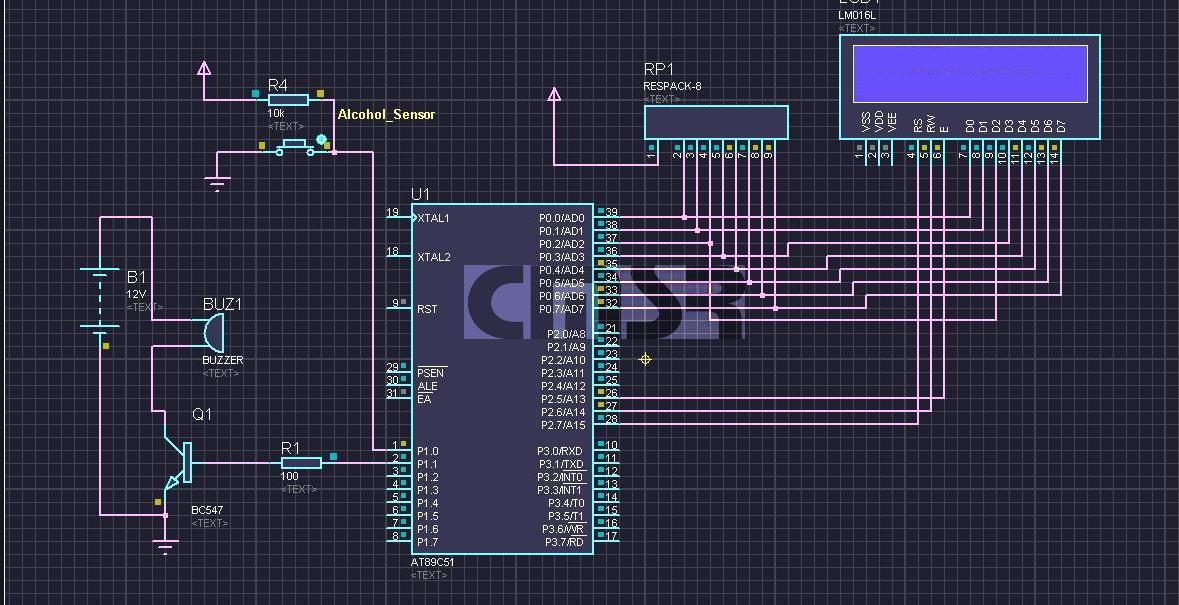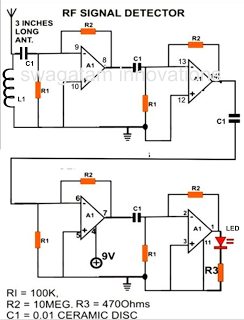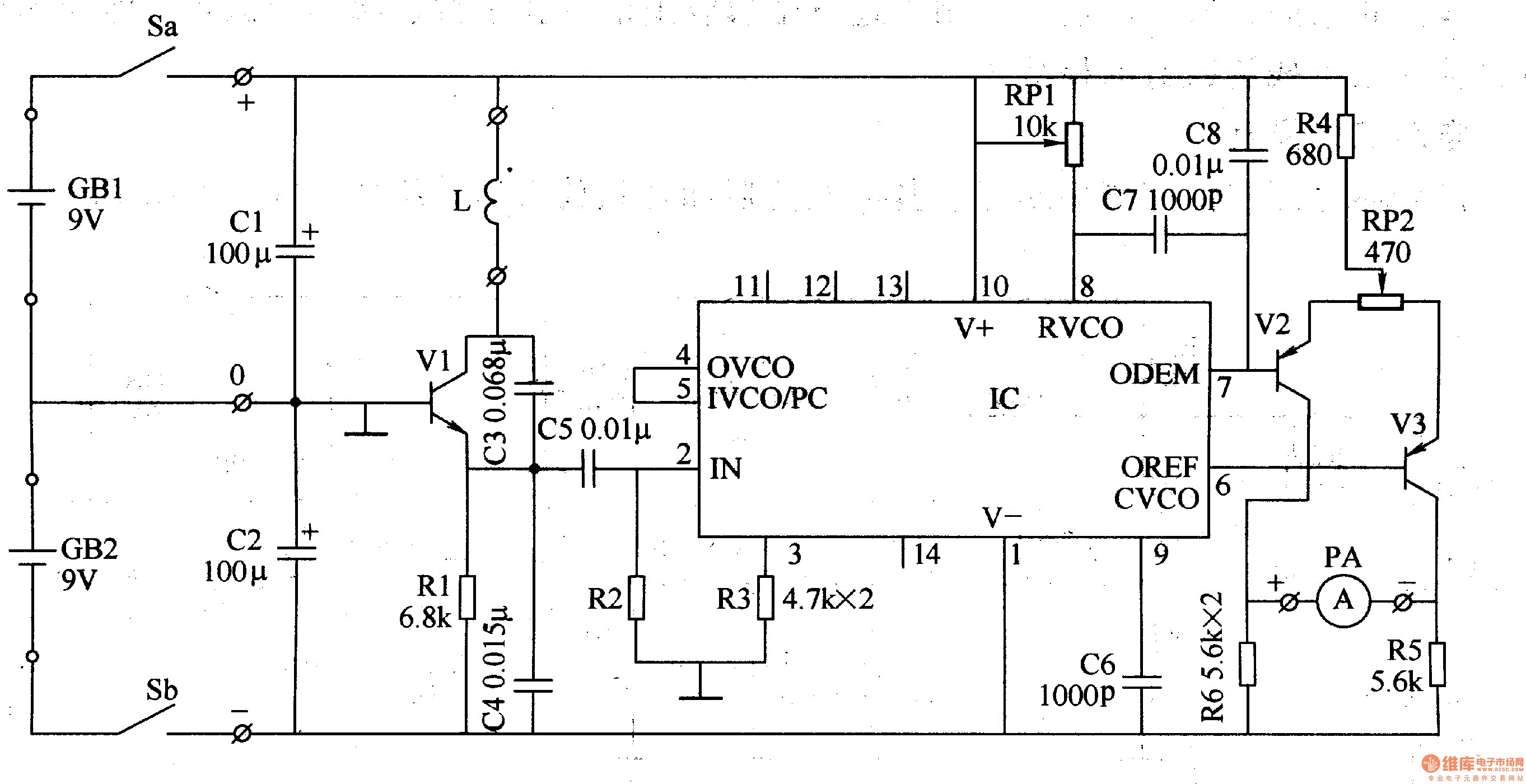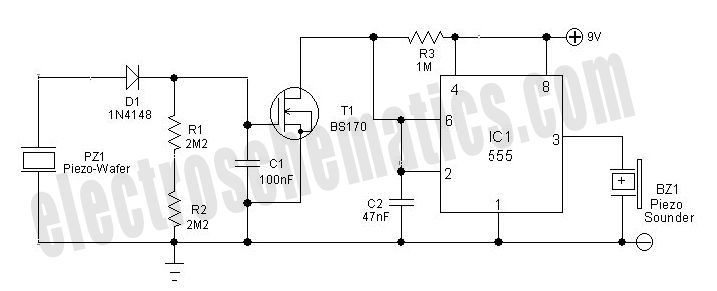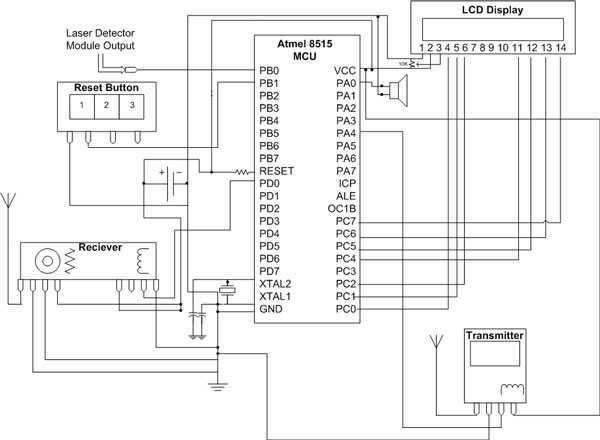
Metal detector 8
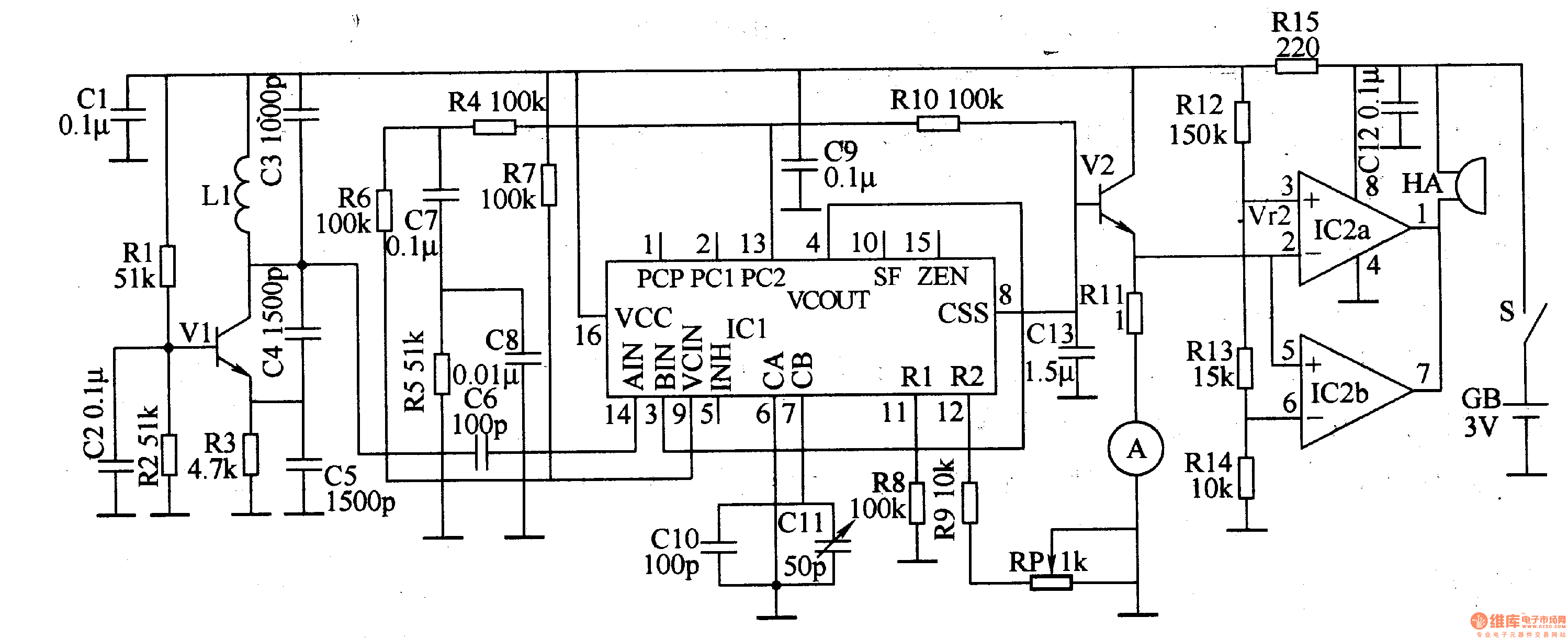
This example describes a metal detector that employs a PLL (phase-locked loop) digital integrated circuit, the MCl4046. It emits an alarm signal upon detecting metal objects and can identify the type of detected material based on the current meter's readings. The device is suitable for locating nails in wood, metal objects in sand, and wires in walls, among other applications. The working principle involves a detection circuit, a PLL phase-locked loop circuit, and a sound alarm circuit. The detection circuit consists of a detection coil (L), a transistor (V1), and several resistors (R1-R3) and capacitors (C1-C5). The PLL phase-locked loop circuit includes the integrated circuit (IC1), additional resistors (R4-R8), and capacitors (C7-C11). The sound alarm circuit is made up of a second transistor (V2), a comparator amplifier integrated circuit (IC2), a buzzer (HA), and more resistors (R8-R14). Resistors R1-R14 are typically 1/4W carbon film or metal film types, while R15 is a 1/2W metal film resistor. The potentiometer (RP) is a small variable resistor. Capacitors C1, C2, C7-C9, C12, and C13 are monolithic types, C3-C6 and C10 are high-frequency ceramic capacitors, and C11 is a semi-variable fine-tuning capacitor. Transistors V1 and V2 are S9018 or 2SC1815 NPN silicon types. IC1 is the MC4046B PLL integrated circuit, and IC2 is the PPC393C operational amplifier integrated circuit.
The metal detector circuit operates through a systematic arrangement of components that work together to achieve effective metal detection. The detection circuit begins with the detection coil (L), which generates an electromagnetic field. When metallic objects enter this field, they induce a change in the field, which is then picked up by the transistor (V1). This change is amplified and processed through the resistors (R1-R3) and capacitors (C1-C5), ensuring that the signal is strong enough for further processing.
The PLL phase-locked loop circuit, utilizing the MC4046B integrated circuit (IC1), plays a crucial role in frequency stabilization and signal processing. It receives the output from the detection circuit and locks onto the frequency of the detected signal. This circuit includes resistors (R4-R8) and capacitors (C7-C11) that are carefully selected to ensure optimal performance and stability of the PLL operation.
The sound alarm circuit is activated when the PLL circuit detects a metal object. The second transistor (V2) acts as a switch, allowing current to flow to the buzzer (HA) when the detection condition is met. The comparator amplifier integrated circuit (IC2) processes the signal from the PLL circuit to determine whether it exceeds a certain threshold, ensuring that only significant detections trigger the alarm. The additional resistors (R8-R14) in this circuit help to set the gain and response characteristics of the alarm system.
Overall, the combination of these circuits results in a reliable metal detection system capable of identifying various types of metal objects in different environments. The careful selection of components, including resistors, capacitors, and integrated circuits, is essential for achieving the desired sensitivity and accuracy in detection. The design can be further enhanced with adjustments to the variable resistor (RP) and the fine-tuning capacitor (C11) to cater to specific detection requirements.This example describes a metal detector which uses a PLL (phase locked loop) digital integrated circuit MCl4046, it can emit the alarm signal when detects metal objects, and it can determine detected material which is based on current meter`s instructions. The device is suitable for detection of nails in wood, the metal objects in sand, wires in w alls and so on. The working principle. The metal detector circuit is composed of dection circuit, PLL phase-locked loop circuit and sound alarm circuit, it is shown in Figure 8-74. Detectioncircuit is composed of the detection coil L, the transistor Vl, resistors Rl-R3, capacitors Cl-C5.
PLL phase-locked loop circuit consists of integrated circuit ICl, resistors R4-R8, capacitor C7-Cll. Sound alarm circuitis composed ofthe transistor V2, comparing amplifier integrated circuit IC2, buzzer HA, resistors Rg-R14. Rl-Rl4 use 1/4W carbon film resistors or metal film resistors; Rl5 uses 1/2W metal film resistors. RP uses small potentiometer or variable resistor. Cl, C2, C7-C9, Cl2 and C13 select monolithic capacitors; C3-C6 and ClO use high-frequency ceramic capacitors; C11 uses fine-tuning capacitor (semi variable capacitor).
Vl and V2 use S9018 or 2SCl815 NPN silicon transistor. ICl uses MCl4046B PLL PLL CD4046 integrated circuit; IC2 uses PPC393C type operational amplifier integrated circuit. 🔗 External reference
The metal detector circuit operates through a systematic arrangement of components that work together to achieve effective metal detection. The detection circuit begins with the detection coil (L), which generates an electromagnetic field. When metallic objects enter this field, they induce a change in the field, which is then picked up by the transistor (V1). This change is amplified and processed through the resistors (R1-R3) and capacitors (C1-C5), ensuring that the signal is strong enough for further processing.
The PLL phase-locked loop circuit, utilizing the MC4046B integrated circuit (IC1), plays a crucial role in frequency stabilization and signal processing. It receives the output from the detection circuit and locks onto the frequency of the detected signal. This circuit includes resistors (R4-R8) and capacitors (C7-C11) that are carefully selected to ensure optimal performance and stability of the PLL operation.
The sound alarm circuit is activated when the PLL circuit detects a metal object. The second transistor (V2) acts as a switch, allowing current to flow to the buzzer (HA) when the detection condition is met. The comparator amplifier integrated circuit (IC2) processes the signal from the PLL circuit to determine whether it exceeds a certain threshold, ensuring that only significant detections trigger the alarm. The additional resistors (R8-R14) in this circuit help to set the gain and response characteristics of the alarm system.
Overall, the combination of these circuits results in a reliable metal detection system capable of identifying various types of metal objects in different environments. The careful selection of components, including resistors, capacitors, and integrated circuits, is essential for achieving the desired sensitivity and accuracy in detection. The design can be further enhanced with adjustments to the variable resistor (RP) and the fine-tuning capacitor (C11) to cater to specific detection requirements.This example describes a metal detector which uses a PLL (phase locked loop) digital integrated circuit MCl4046, it can emit the alarm signal when detects metal objects, and it can determine detected material which is based on current meter`s instructions. The device is suitable for detection of nails in wood, the metal objects in sand, wires in w alls and so on. The working principle. The metal detector circuit is composed of dection circuit, PLL phase-locked loop circuit and sound alarm circuit, it is shown in Figure 8-74. Detectioncircuit is composed of the detection coil L, the transistor Vl, resistors Rl-R3, capacitors Cl-C5.
PLL phase-locked loop circuit consists of integrated circuit ICl, resistors R4-R8, capacitor C7-Cll. Sound alarm circuitis composed ofthe transistor V2, comparing amplifier integrated circuit IC2, buzzer HA, resistors Rg-R14. Rl-Rl4 use 1/4W carbon film resistors or metal film resistors; Rl5 uses 1/2W metal film resistors. RP uses small potentiometer or variable resistor. Cl, C2, C7-C9, Cl2 and C13 select monolithic capacitors; C3-C6 and ClO use high-frequency ceramic capacitors; C11 uses fine-tuning capacitor (semi variable capacitor).
Vl and V2 use S9018 or 2SCl815 NPN silicon transistor. ICl uses MCl4046B PLL PLL CD4046 integrated circuit; IC2 uses PPC393C type operational amplifier integrated circuit. 🔗 External reference
